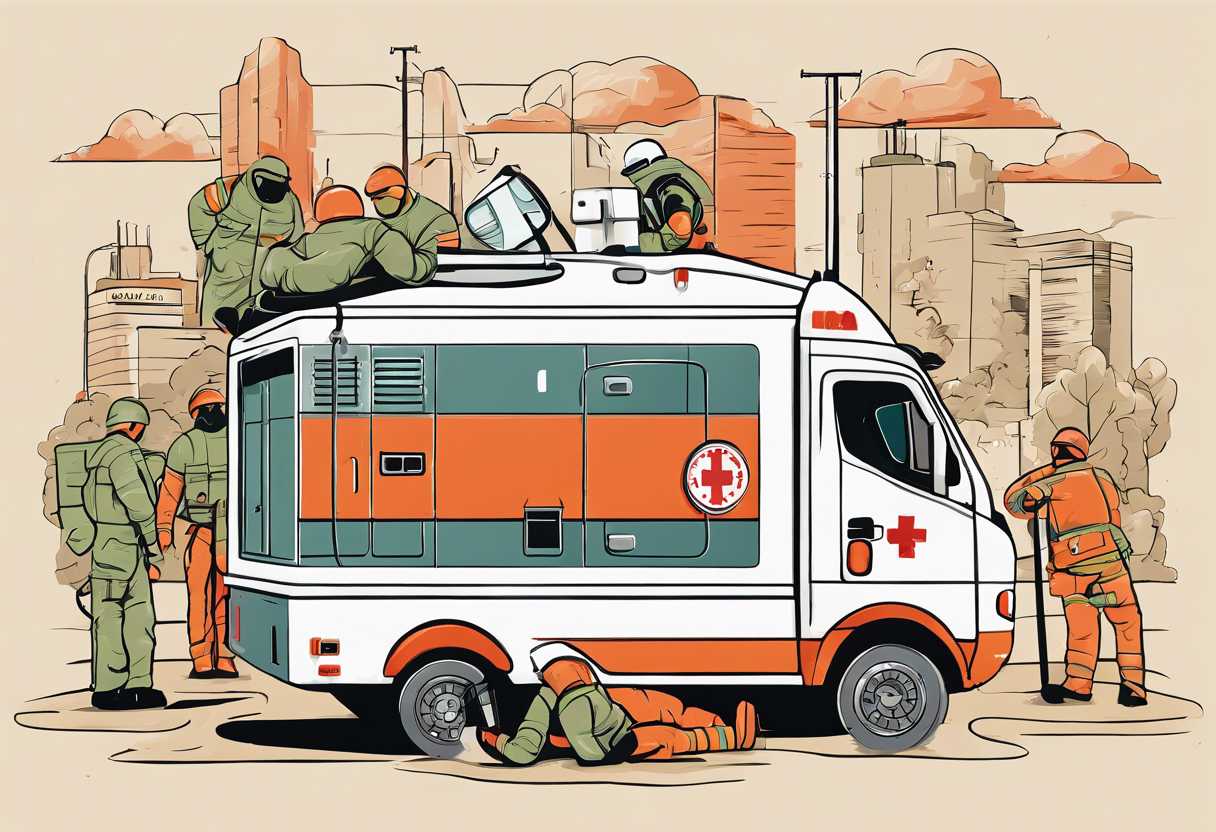Disasters can strike at any time, causing widespread devastation and loss of life. However, with effective disaster management strategies in place, the impact of these catastrophic events can be minimized, ultimately reducing casualties. In this blog post, we will explore the various ways in which disaster management plays a crucial role in minimizing casualties. From the importance of preparedness and effective emergency response strategies to the utilization of technology and community engagement, we will delve into the key factors that contribute to reducing the human toll of disasters. Additionally, we will examine the impact of early warning systems in providing crucial time for evacuation and preparedness. Join us as we uncover the essential elements of disaster management that help save lives and mitigate the impact of natural and man-made disasters.
The Role of Preparedness in Minimizing Disaster Casualties
Understanding the Importance of Preparedness
Preparedness plays a crucial role in minimizing disaster casualties. When individuals, communities, and governments are well-prepared for potential disasters, they are better equipped to respond effectively and mitigate the impact of the disaster. This includes having emergency plans in place, access to necessary resources, and the ability to quickly mobilize response efforts.
Key Components of Disaster Preparedness
Disaster preparedness involves several key components, including risk assessment, emergency planning, resource management, and training and education. By conducting thorough risk assessments, identifying potential hazards, and developing emergency plans, individuals and organizations can proactively prepare for disasters. Effective resource management ensures that necessary supplies and support are readily available, while training and education help to ensure that individuals are equipped with the knowledge and skills needed to respond to disasters.
The Impact of Preparedness on Disaster Casualties
Research has shown that communities and organizations with robust disaster preparedness measures in place experience lower casualty rates and less severe damage when disasters occur. By being prepared, individuals and communities can minimize the impact of disasters, reduce the number of casualties, and expedite recovery efforts. This underscores the importance of investing in disaster preparedness and ensuring that it remains a priority for all stakeholders.

Effective Emergency Response Strategies for Reducing Casualties
Early Warning Systems
Early warning systems play a crucial role in reducing casualties during emergencies. These systems can provide advance notice of impending disasters, such as natural disasters or industrial accidents, allowing authorities to take proactive measures to mitigate the impact. By leveraging technology and real-time data, early warning systems can alert the public and emergency responders, giving them valuable time to prepare and respond effectively.
Community Preparedness and Training
Community preparedness and training are essential components of effective emergency response strategies. When individuals and communities are educated and trained in emergency response protocols, they are better equipped to take appropriate actions during a crisis. This can include first aid training, evacuation drills, and awareness campaigns to educate the public about potential hazards and how to respond to them. By empowering communities to be proactive and resilient, casualties can be minimized in the event of an emergency.
Coordination and Communication
Coordination and communication among various stakeholders, including government agencies, emergency responders, and the private sector, are critical for reducing casualties during emergencies. Establishing clear lines of communication, coordinating response efforts, and sharing information in real-time can help ensure a cohesive and efficient response. This can involve the use of communication technologies, such as radio systems and mobile apps, to facilitate seamless communication and collaboration among different entities involved in the emergency response.

Importance of Community Engagement in Disaster Risk Reduction
The Role of Community Engagement in Disaster Risk Reduction
Community engagement plays a crucial role in disaster risk reduction. When communities are actively involved in identifying and addressing potential risks, they are better equipped to respond effectively in the event of a disaster. By engaging with local residents, organizations, and authorities, it is possible to develop comprehensive disaster risk reduction plans that take into account the specific needs and vulnerabilities of the community.
Building Resilience Through Community Engagement
Engaging with the community is essential for building resilience in the face of disasters. When individuals and groups are involved in the planning and implementation of risk reduction measures, they are more likely to take ownership of these initiatives and actively participate in their success. This sense of ownership and responsibility can lead to a more resilient community that is better prepared to face and recover from disasters.
Empowering Communities Through Knowledge and Skills
Community engagement in disaster risk reduction also serves to empower individuals and groups by providing them with the knowledge and skills necessary to mitigate risks and respond effectively to disasters. Through education and training programs, communities can learn about potential hazards, develop emergency response plans, and acquire the skills needed to protect themselves and others in times of crisis.
Utilizing Technology and Innovation to Enhance Disaster Management
The Role of Technology in Disaster Management
Technology plays a crucial role in enhancing disaster management efforts. From early warning systems to communication tools, technology has revolutionized the way we prepare for and respond to disasters. For example, drones are now being used to assess damage and deliver aid in hard-to-reach areas, while social media platforms provide real-time updates and help coordinate relief efforts. By leveraging technology, disaster management teams can improve their response times and save lives.
Innovative Solutions for Disaster Preparedness
One innovative solution that has gained traction in disaster management is the use of predictive analytics. By analyzing historical data and environmental factors, predictive analytics can help identify areas at high risk of disasters and allocate resources accordingly. Additionally, the development of mobile apps and online platforms has made it easier for individuals to access emergency information and resources, empowering them to take proactive measures to protect themselves and their communities.
The Future of Disaster Management Technology
The future of disaster management technology looks promising, with advancements in artificial intelligence and machine learning. These technologies have the potential to automate certain aspects of disaster response, such as resource allocation and decision-making, allowing for more efficient and effective operations. Furthermore, the integration of Internet of Things (IoT) devices and sensors can provide real-time data on environmental conditions, enabling quicker and more accurate response efforts.
The Impact of Early Warning Systems on Minimizing Casualties in Disasters
Early Warning Systems: A Vital Tool for Disaster Preparedness
Early warning systems play a crucial role in minimizing casualties in disasters by providing timely and accurate information to at-risk communities. These systems utilize various technologies such as sensors, satellites, and communication networks to detect and monitor potential hazards, including natural disasters like earthquakes, tsunamis, and hurricanes. By alerting authorities and the public about impending threats, early warning systems enable proactive measures to be taken, ultimately saving lives and reducing the impact of disasters.
The Role of Communication and Education in Early Warning Systems
Effective communication and education are essential components of early warning systems. It is not enough to simply have the technology in place; it is equally important to ensure that the information is disseminated in a clear and accessible manner to the affected population. This includes utilizing multiple communication channels such as radio, television, mobile phones, and social media to reach as many people as possible. Additionally, educating communities about how to respond to warnings and take appropriate action can significantly enhance the effectiveness of early warning systems in minimizing casualties.
Success Stories: The Impact of Early Warning Systems in Real-Life Scenarios
Several real-life examples demonstrate the tangible impact of early warning systems in minimizing casualties during disasters. For instance, in the case of the 2004 Indian Ocean tsunami, countries with effective early warning systems were able to evacuate coastal areas and significantly reduce the loss of life compared to those without such systems in place. Similarly, in earthquake-prone regions like Japan, early warning systems have been credited with providing valuable seconds or even minutes of advance notice, allowing people to take cover and avoid injury. These success stories underscore the critical role that early warning systems play in disaster risk reduction and management.
Conclusion
Disaster management plays a crucial role in minimizing casualties during natural or man-made disasters. Through preparedness, effective emergency response strategies, community engagement, technology, and early warning systems, the impact of disasters can be mitigated, and lives can be saved.
Preparedness is key in reducing the impact of disasters on communities. By having plans in place and conducting regular drills and exercises, individuals and organizations can better respond to emergencies, ultimately minimizing casualties.
Effective emergency response strategies, such as swift and coordinated actions by first responders and emergency services, are essential in reducing casualties during disasters. These strategies can help in providing timely medical assistance and evacuation, thereby saving lives.
Community engagement is also vital in disaster risk reduction. By involving local communities in planning and decision-making processes, it is possible to build resilience and enhance the overall response to disasters, ultimately minimizing casualties.
Utilizing technology and innovation can significantly enhance disaster management efforts. From advanced warning systems to communication tools, technology plays a crucial role in improving preparedness and response, ultimately reducing the impact of disasters on human lives.
Early warning systems are critical in minimizing casualties during disasters. By providing timely alerts and information, these systems can help individuals and communities to take necessary precautions and evacuate to safer areas, ultimately saving lives.
As we continue to face the challenges of natural and man-made disasters, it is essential to prioritize disaster management efforts to minimize casualties. By implementing the discussed strategies and leveraging the power of technology and community engagement, we can work towards a safer and more resilient future.
Together, we can make a difference in minimizing the impact of disasters and saving lives. Let us all take an active role in disaster management and contribute to building a safer and more prepared society.
Stay informed, stay prepared, and stay safe.

